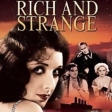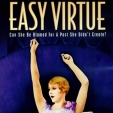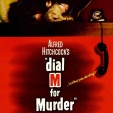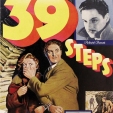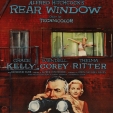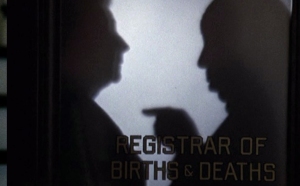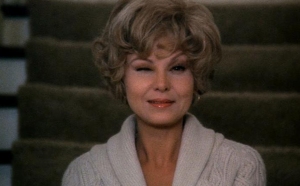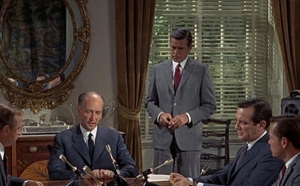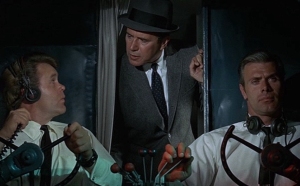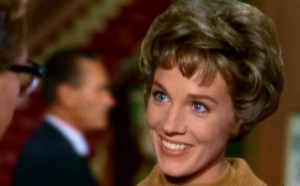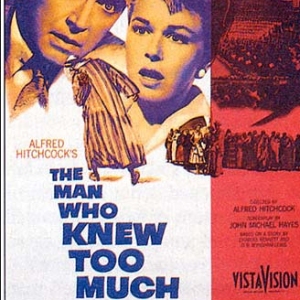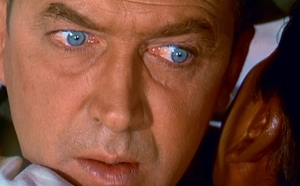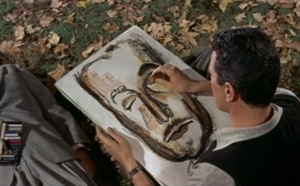After a mad 52 days the Hitchcock-a-thon is at its end. It’s been great discovering some overlooking gems that I otherwise wouldn’t have sought out. But, like every artist, Hitchcock also made plenty of films worth skipping over. And there’s some that can truly be classified as awful. It’s time from one last big round-up. Here is my personal list of every Hitchcock feature film ranked from worst to best.
52. Waltzes from Vienna (1934)
An unbelievably dreary period drama about Johann Strauss Jr that somehow manages to be both sickly and flavourless. Hitchcock was barely getting any other film offers at the time and it shows. By his standards, it’s uncharacteristically passionless.
At 63 minutes the nicest thing you can say about Number 17 is “as least it’s over with quickly.” Not that it feels like it. The jumbled story makes it hard to know what’s going on while the paper-thin, unlikeable characters will ensure you don’t care anyway.
 50. Topaz (1969)
50. Topaz (1969)
There are tectonic plates with better pacing than this Cold War spy story. With hastily written scenes and multiple alternative endings, Topaz represents Hitchcock at his sloppiest and his most world-weary.
Hitchcock’s tale of Cornish smugglers is desperately limp. The only small enjoyment you might squeeze out of it is the ludicrously camp performance by Charles Laughton as the pantomime-ish villain, who takes overacting to new levels.
Another failed period drama, this time in 1830s Australia. Bright colours and swooping camera shots can’t distract from the hopelessly melodramatic script. A complete waste of Ingrid Bergman and Joe Cotten. And one doesn’t simply waste Ingrid Bergman.
 47. Champagne (1928)
47. Champagne (1928)
Hitchcock called Champagne the worst film of his career. It’s certainly difficult to defend. Betty Balfour manages to inject a bit of fizz as the millionaire’s daughter forced to learn the hard knocks of life, but everything else is flat.
 46. Murder! (1930)
46. Murder! (1930)
Who killed Edna Druce? More importantly: why should I care? This thespian-filled whodunit barely functions as piece of drama and stumbles even more as a murder mystery. Hitchcock was still finding his feet as silent cinema moved into talkies.
Possibly the of the most disjointed film in Hitchcock’s canon. Noël Coward style marital antics for the first half; a harsh seaward journey with rough sailors for the second. Problem is: neither half is great, thanks to the oafish main characters.
 44. Juno and the Paycock (1930)
44. Juno and the Paycock (1930)
A compelling story and strong performances lie under the surface of this early Irish talkie. But you have get past horribly grating audio and stunted, theatrical pacing to uncover its merits. Only diehard Hitchcock fans should attempt.
The great John Gielgud looks bored out of his mind in this early spy thriller. Madeleine Carroll and Peter Motherfuckin’ Lorre both try to liven things up and the script throws some interesting themes in play, but as a whole it’s underwhelming.
Aside from one tense murder scene, this Cold War spy story is as dull as ditch-water. Paul Newman and Julie Andrews look lost as the leads and the two hour running time feels dragged out. Torn Curtain was one of Hitchcock’s most unhappy directing jobs. It shows.
 41. The Trouble with Harry (1955)
41. The Trouble with Harry (1955)
Some laud Hitchcock’s off-kilter comedy as a success in dark deadpan humour. I find it tiresome. Pretty cinematography and the first of many great collaborations with Bernard Herrmann make it watchable. But only just.
If you were generous you might call The Skin Game a slow-burner. If you were cruel you might say it never ignites at all. While this story of feuding rural families can’t be called thrilling, Phyllis Konstam provides the film with an essential dose of human drama.
A smashing last 20 minutes aren’t enough to make up for an hour of faffing around. Isabel Jeans springs into life as the falsely-slandered heroine for film’s final act and gives a simultaneously witty and tragic performance. Why couldn’t we have had that earlier?
While not as irredeemably awful as some have claimed, The Paradine Case takes an interesting idea about a lawyer’s infatuation with the woman he’s meant to represent, only to run it into the ground. Great actor Gregory Peck at his most uninteresting.
 37. Downhill (1927)
37. Downhill (1927)
1920s heart-throb Ivor Novello gives a strong performance as a falsely accused schoolboy in this a bleak depiction of “polite society”. Shame about the crudely stereotyped supporting characters and the clunky visual symbolism.
Hitchcock’s attempt at a wacky, screwball American comedy is harmless enough, but certainly can’t be described as “funny”. Carole Lombard is a fiery lead, but the script doesn’t give her (or anyone) much to work with.
This placid, rural comedy is likely to bore many viewers to tears. While it’s neither funny nor suspenseful, it has a certain quaint charm that earns it a space in my heart. Also Jameson Thomas gives me serious mustache envy.
Even the effortlessly cool Marlene Dietrich isn’t enough save Stage Fright from mediocrity. The film’s claustrophobic climax is an intense high note in an otherwise uneventful drama about deception in the theatrical world.
![]() 33. I Confess (1953)
33. I Confess (1953)
A stone-faced Montgomery Clift ensures an unwavering solemnity in this tale of a falsely accused Catholic priest. It doesn’t fully captivate as a drama thanks to the by-the-numbers script. At least Quebec looks pretty.
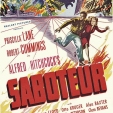 32. Saboteur (1942)
32. Saboteur (1942)
Hitch’s first American take on his 39 Steps formula has some big blockbuster set-pieces and ticks the “innocent man on the run” boxes, but lacks flare. It needed a more compelling lead couple or a tighter script to push it into North by Northwest territory.
Even as one of his lighter films, the last project from the Master of Suspense lacks the the joyful corniness of To Catch a Thief or North by Northwest. As a mystery-based romp it serves it’s purpose, but as a final swansong we’re left wanting more.
 30. Foreign Correspondent (1940)
30. Foreign Correspondent (1940)
This big budget blockbuster showcases what Hitch is capable of when handed an enormous paycheck and allowed to let his imagination run wild. There are a few flabby bits that don’t work, but overall it’s a rollicking wartime adventure with a strong sense of historical urgency.
They don’t come much pulpier than this. There’s a lot to enjoy in Ingrid Bergman’s Hitchcock debut, if you can get over the ludicrous plot devices. Hitchcock’s spun better mysteries in his time, but how many others have a fantasy sequence by Salvador Dalí?
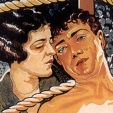 28. The Ring (1927)
28. The Ring (1927)
Hitchcock masters fast-paced editing and rich visual symbolism in The Ring, also notable for being the only original screenplay he ever personally wrote. It’s a masterpiece in technical terms, but the characters aren’t as well defined as in some of his other silents.
 27. Suspicion (1941)
27. Suspicion (1941)
Cary Grant shows an unexpected dark side alongside Joan Fontaine in her Oscar winning performance. It’s a excellent examination of psychological entrapment and paranoia…right up until the end. Then it pulls a major cop-out. Shame.
 26. Frenzy (1972)
26. Frenzy (1972)
A second wind for the aging director in the final stages of his career. With scenes of explicit sexual violence, there’s an underlying nastiness to Frenzy that makes it difficult viewing, but there’s no denying its brutal effectiveness.
 25. The Man Who Knew Too Much (1956)
25. The Man Who Knew Too Much (1956)
A solid remake of Hitchcock’s own 1934 film. While it lacks the off-the-wall zaniness of the original, it goes through the motions with gusto. And when you’ve got James Stewart as your lead the film’s always going to have a certain something.
The dialogue has a slightly mechanical quality in this 3D adaption of the successful stage play, but a suave performance from Ray Milland holds it all together. Grace Kelly isn’t at her absolute strongest in her Hitchcock debut, but she’s still a smash.
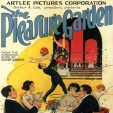 23. The Pleasure Garden (1925)
23. The Pleasure Garden (1925)
There’s a lot to admire in Hitchcock’s lively first feature film. There are some slight pacing issues, but there’s sophisticated themes in play about marital mistrust, helped along by a talented cast and an absurdly cute dog.
It doesn’t come much flirtier than this. The dream pairing of Cary Grant and Grace Kelly is the biggest draw to this camp, frothy romp of a film. Both Grant and Kelly have given stronger performances, but rarely are they this unabashedly fun.
 21. Sabotage (1936)
21. Sabotage (1936)
If you like your spy films unrelentingly serious, Sabotage might be the Hitchcock for you. It’s an emotion-driven drama that expertly plays off the political paranoia building in Europe before the outbreak of World War II with great effect.
 20. Blackmail (1929)
20. Blackmail (1929)
Britain’s first talkie also serves as a farewell tribute to the silent era. There are a few jarring editing moments as Hitchcock struggled to film his feet in the new world of sound, but the central story is gripping with a superb performance from Czech star Anny Ondra.
Many people consider The Lodger to be the first “true” Hitchcock film and it’s easy to see why. Ivor Novello is haunting as the mysterious visitor in fog-covered London and the film is first Hitchcock to explicitly make the thematic connection between sex and death.
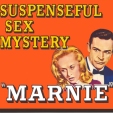 18. Marnie (1964)
18. Marnie (1964)
The accusations of harassment surrounding the production of Marnie make it a tricky watch, not helped by the deeply problematic ending. But there are times where the film verges close to masterpiece territory, particularly with Tippi Hedren’s career topping performance.
 17. Lifeboat (1944)
17. Lifeboat (1944)
The self-imposed restrictions of shooting the whole movie inside one small vessel work marvellously well towards creating a sense of claustrophobia in Hitchcock’s last wartime drama. As an examination of trust and human interaction it excels.
One of the most unfairly overlooked of Hitchcock’s films, partly because he himself dismissed as “banal”. But the love-triangle story is at its best here, taking the time to make you care about all three of the characters and not providing any easy answers.
Easy to dismiss as a beat for beat retread of The 39 Steps, but this deeply English thriller is just too damn fun to overlook. The subtly erotic dialogue between Derrick De Marne and Nova Pilbeam is easily some of the best from Hitchcock’s early years.
 14. Rope (1948)
14. Rope (1948)
The “all in one take” gimmick doesn’t quite work in this cat-and-mouse murder thriller, but so much else is done right, it’s an easy flaw to forgive. James Stewart is solid in his Hitchcock debut, but it’s John Dall as camp killer Brandon who steals the show.
Hitchcock often maintained that this visually symbolic tale of evil creeping into tranquil suburbia was the greatest of his films. There’s a few niggling plot points that trip up the story, but the mounting paranoia is well executed and Joe Cotton is a magnificent villain.
 12. The Man Who Knew Too Much (1934)
12. The Man Who Knew Too Much (1934)
After five years of dud after dud in the early thirties, The Man Who Knew Too Much feels like a jolt of lightning in Hitchcock’s career. Peter Motherfuckin’ Lorre leads the strong cast through through Hitchcock’s first true voyage into pulp.
 11. Vertigo (1958)
11. Vertigo (1958)
I’m of the minority opinion that the critical reception of Vertigo, initially dismissive, has now swung back too far in its unreserved adoration of this psychological mystery. Vertigo is still a great achievement, but I wouldn’t rank it as one Hitchcock’s absolute best.
The quintessential “innocent man on the run” thriller that set the template for so many Hitchcock films to come. Often regarded as the best of Hitchcock’s British years, it captures a pure spirit of adventure better than almost any other film of the time.
A rare detour into neorealism for Hitchcock in his only film explicitly based on a true story. There doesn’t appear to be an easy way out for Manny, played superbly by Henry Fonda, in one of the director’s more overlooked masterpieces.
The only Hitchcock film ever to win the Oscar for Best Picture is a superb way to kick off the director’s Hollywood career. It’s Hitchcock’s most successful film about the theme of marital mistrust as well as his only collaboration with the great Laurence Olivier
One of the most ridiculous films in the director’s canon, but also one of his most flat-out enjoyable. This absurd spy fantasy is a joy from start to finish with several excellent sequences along the way: most famously, the crop duster chase scene.
 6. Strangers on a Train (1951)
6. Strangers on a Train (1951)
A superb concept about “swapping” murders expertly delivered in this tense thriller, helped by the powerhouse performances by Farley Granger and Robert Walker. It has been argued that Strangers on a Train heralded in the Golden Age of Hitchcock. Agreed.
Tippi Hedren dazzles in her first feature film and Hitchcock’s only example of paranormal horror. Hitchcock keeps the terror alien by never fully revealing the reason behind the feathered fury and with a chilling use of sound effects.
A film I could watch every week for the rest of my life. There hasn’t been a more sparkling lead Hitchcock couple than Margaret Lockwood and Michael Redgrave. The central mystery is exciting and the wonderful array of supporting characters is icing on the cake.
Cary Grant and Ingrid Bergman give the performances of their career in what is Hitchcock’s most elegant film. As fusion of romance and spy drama, it finds the balance perfectly. But it’s Claude Rains who holds the film together with his understated performance.
James Stewart and Grace Kelly are at the top of their game in Hitchcock’s best exploration of voyeurism and mounting suspicion. The confines of a New York apartment, stagnating in the summer heat, prove the perfect setting to one of his most suspenseful scenarios.
An obvious choice for the number one slot, but there’s no escaping just how outrageously good Psycho is. The balance Hitchcock strikes between what he reveals to the audience and what he keeps concealed makes his most famous film also his best.





